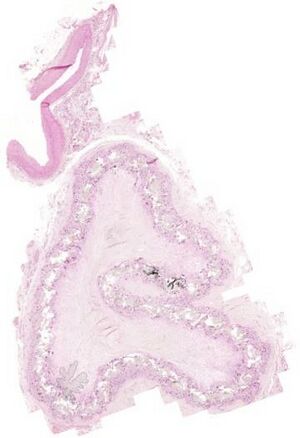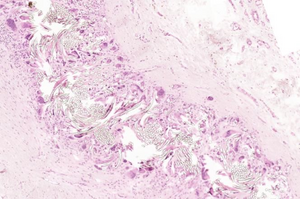30. Foreign body granuloma
Staining: HE

Organ: Previously sutured tissue
Description:
On the top of the slide we can see a vessel that is opened. In the middle of the slide we see some connective tissue. Along the periphery we see some non-organic, weird material. Around the weird material we can see some multi-nucleated cells.
Diagnosis: Foreign body granulomas
Causes:
- Remaining foreign bodies inside the body, like sutures that aren’t removed.
Theory:
The non-organic material is the remnant of some polyfilamentous suture. Around it is granulomas starting to form. Granulomas are a type of inflammation characterized by a collection of activated macrophages with scattered lymphocytes. Only a limited number of diseases cause granulomatous inflammation. This type of inflammation can occur as part of a type 4 hypersensitivity reaction or not. In foreign body granulomatosis is there no type 4 hypersensitivity reaction.

An essential characteristic for granulomas is the presence of epithelioid cells. These cells are activated macrophages that also resemble epithelial cells, hence the name. They have pink, granular cytoplasm with indistinct cell boundaries. Sometimes we also see giant cells. They look like a large mass of cytoplasm with many nuclei. Giant cells are formed when multiple epithelioid cells fuse together. In this slide we see both cell types.
Three types of giant cells exist. The Langhans giant cells are found mostly in tuberculosis and has its nuclei spread along the periphery of the cell. The foreign body giant cells occur in response to foreign bodies and have their nuclei spread throughout the cell. The touton giant cells are found in xanthogranulomas and fat necrosis. They have a foamy appearance with the nuclei arranged in a ring.
Granulomas are formed when the macrophages can’t digest whatever they’ve phagocytosed, like sutures or certain bacteria. The granulomas “wall off” the offending agent, however the macrophages might die and cause fibrosis, which can cause more problems than the offending agent.

